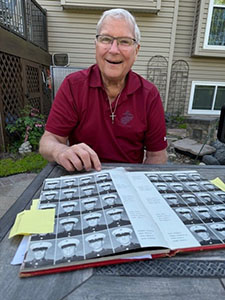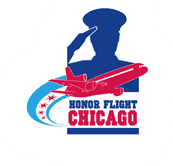Marines Vietnam War Naperville, IL Flight date: 05/14/25
By Charlie Souhrada, Honor Flight Chicago Veteran Interview Volunteer
Bruce Engel used his mechanical and problem-solving skills to keep personnel and supplies moving in Vietnam. Getting to and from Southeast Asia wasn’t quite so simple.
Growing up on a family dairy farm in Howard Lake, Minnesota, with one brother and two sisters, Bruce learned the value of hard work as soon as he could walk – milking cows in the morning before school, and in the afternoon when he returned home. His parents, Duane and Marilyn, ran the 200-acre operation where, in addition to raising Holsteins for their high milk production, the family grew corn, oats, soybeans, and a little bit of everything else.
“As a kid, something was always going on,” he says. “We were responsible for helping on the farm and that was that. If we got caught up with our chores, we’d go help a neighbor. There wasn’t time for part-time work outside the farm!”
After graduating from Howard Lake High School in 1964, Bruce was ready to follow a different path and found work as a mechanic in a truck repair shop. “I didn’t see myself staying on the farm,” he remembers. “You’re tied down and can’t go anywhere or do anything. It was a lot of hard work for very little in return. In a manner of speaking, I was saying: I love you dad, but I’ve got to go find my way.”
Less than two years later, an aunt who worked for the county, learned Bruce’s draft number was coming up and shared the news. To gain some control and select his preferred branch of service, Bruce visited the military recruiting stations in nearby St. Cloud and found every branch, but the Marines had met their quotas. “That’s how I ended up in the Marines, which upset my dad,” he explains. “He was a Merchant Marine during World War II and had some experience with the various branches of service.” He admits that he probably didn’t listen to his father’s advice at the time. “I thought I knew it all. When I got to boot camp, I realized I knew nothing!”
In January 1966, Bruce began eight weeks of Marine Corps Recruit Training in San Diego. “It was tough,” he admits. “Working on the farm helped because I was in pretty good shape, but overall, it was a rude awakening!” After completing boot camp, Bruce was sent up the California coast to Camp Pendleton for three weeks of field training which included weapons, maneuvers, and various physical and mental tests. “It was California, but we knew we were getting ready for Vietnam,” he says. “I was just trying to survive!”
Camp Lejeune in North Carolina was Bruce’s next stop, where he learned to work on 2 ½-ton trucks, tearing them apart and putting them back together. During this time, an outbreak of meningitis put his barracks on quarantine. “It was awful,” he says. “Surprisingly, the night before we were supposed to leave, another guy thought he came down with it and nobody said a word because we all wanted to get out of there!”
Bruce was sent back to San Diego where he shipped out to Southeast Asia with 4,200 other troops aboard the USS General LeRoy Eltinge (AP-154), a WWII-vintage transport ship that stalled in the Pacific Ocean and had to be pulled into Pearl Harbor. After some repairs, the Eltinge continued its journey and landed in Okinawa in June 1966, where Bruce took jungle warfare training.
Eventually Bruce arrived in Vietnam. “It was like walking into an oven,” he remembers. “The heat and the smell are something I’ll never forget. I could hear bombs and shooting close by. Right then, I knew this was for real.”

Bruce’s new reality quickly became clear when he learned his frontline assignment entailed hustling between Khe Sanh and Chu Lai repairing “Deuce and a Half” trucks. In this role, it wasn’t unusual to work on a truck while under enemy fire. Oftentimes, a truck would get blown up and needed to be dragged or flown in under a helicopter. “Our job was to get them running again as fast as we could,” he says. Occasionally, Bruce was called into combat, filling in when and where he was needed. “It was a real challenge. I’m proud of what we did.”
A back injury from his helicopter being hit by an R.P.G. brought his time in Vietnam to a screeching halt. He was sent to a military hospital at Tachikawa Airfield in Japan where he was kept in traction and told he needed extensive surgery to avoid paralysis. To get better care, Bruce was flown back to the United States on a C-130 Hercules aircraft that had been converted into a hospital transport. But, just like his journey to Southeast Asia, Bruce’s return trip got stalled.
“We had a planned refueling stop in Alaska and while we were there, a snowstorm came in an made it impossible for us to take off,” he remembers. “They took everybody off the plane, brought us into a high school, and we stayed there for quite a while until the storm was gone. Coming home was about as eventful as going there had been!”
Back in the lower 48 states, Bruce went from Walter Reed National Medical Center in Maryland, to Naval Station Great Lakes, then eventually back home to Minnesota where his back was successfully repaired. His service formally ended in September 1968, when he received a “General Discharge Under Honorable Conditions” – the equivalent to an honorable discharge.
At home with his parents, Bruce recalls being wheelchair bound while his body healed. That year, he married his high school sweetheart, Carol, and the couple eventually welcomed two children – Jason and Jodi.
When he was back to full strength, Bruce found work in the parts department of a local Dodge/Chrysler dealership. There, his mechanical and problem-solving skills were highly prized, and he eventually bought the dealership when the owner decided to retire. “The guy offered me the franchise for $10,000, which I didn’t have,” he says. “So, I talked it over with my dad and we went down to the bank, signed a note, and I became a car dealer for the next 18 years.”
He admits the deal seems like a bargain considering today’s economy but explains Howard Lake had fewer than 800 residents at the time. “We sold a lot of trucks to farmers and Dodge Chargers and Challengers to my friends!”
In 1985, Bruce sold the dealership and went to work for AT&T. Unfortunately, Carol passed away the following year. Immersing himself in his work, Bruce found success in the company’s security division, moving from Detroit to Indianapolis, and eventually landing in Chicago.
In 1991, AT&T left the security business, forcing Bruce to open his own company – S&S Systems of America, where he installed fire and burglar alarm systems throughout Northern Illinois and the Chicago area.
In 2017, Bruce met his partner, Anita, when a secretary filled out an online dating profile for him. “My secretary wanted me to find somebody to go out and have fun with, so she put me on a dating site and that’s how Anita and I met!” During their first date, the couple discovered they shared the same birthday – December 14. They also learned their mothers shared the same birthdate, and their daughters were born one day apart. “We hit it off and have been together for eight years now. Life is good!”
In 2021, COVID and medical issues forced him to retire. Nowadays, Bruce focuses on his health and an active social life with Anita by his side. He’s involved in the American Legion, VFW, and his church – Trinity Lutheran Church in Lisle. The couple also has an active travel schedule with plans for a European river cruise later this month.
“My military service gave me the discipline to get things done,” he says. “Knowing what all of us went through and the dedication it takes to serve, I’m honored and looking forward to spending time with my fellow veterans!”
Thank you, Bruce! We hope you enjoy your well-earned, much-deserved day of honor!


